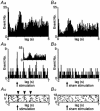Resetting of sympathetic rhythm by somatic afferents causes post-reflex coordination of sympathetic activity in rat
- PMID: 11389210
- PMCID: PMC2278634
- DOI: 10.1111/j.1469-7793.2001.0537a.x
Resetting of sympathetic rhythm by somatic afferents causes post-reflex coordination of sympathetic activity in rat
Abstract
1. We have proposed previously that graded synchronous activity is produced by periodic inputs acting on weakly coupled or uncoupled oscillators influencing the discharges of a population of cutaneous vasoconstrictor sympathetic postganglionic neurones (PGNs) in anaesthetized rats. 2. Here we investigated the effects of somatic afferent (superficial radial nerve, RaN) stimulation, on the rhythmic discharges of this population. We recorded (1) at the population level from the ventral collector nerve and (2) from single PGNs focally from the caudal ventral artery of the tail. 3. Following RaN stimulation we observed an excitatory response followed by a period of reduced discharge and subsequent rhythmical discharges seemingly phase-locked to the stimulus. 4. We suggest that the rhythmical discharges following the initial excitatory response (conventional reflex) result from a resetting of sympathetic rhythm generators such that rhythmic PGN activity is synchronized transiently. We also demonstrate that a natural mechanical stimulus can produce a similar pattern of response. 5. Our results support the idea that in sympathetic control, resetting of multiple oscillators driving the rhythmic discharges of a population of PGNs may provide a mechanism for producing a sustained and coordinated response to somatic input.
Figures





Comment in
-
Multiple oscillators in autonomic control.J Physiol. 2001 Jun 1;533(Pt 2):313. doi: 10.1111/j.1469-7793.2001.0313a.x. J Physiol. 2001. PMID: 11389193 Free PMC article. Review. No abstract available.
Similar articles
-
Cutaneous sympathetic motor rhythms in the decerebrate rat.Neuroscience. 2003;117(4):981-9. doi: 10.1016/s0306-4522(02)00969-7. Neuroscience. 2003. PMID: 12654350
-
Coherent rhythmic discharges in sympathetic nerves supplying thermoregulatory circulations in the rat.J Physiol. 2000 Mar 1;523 Pt 2(Pt 2):449-57. doi: 10.1111/j.1469-7793.2000.00449.x. J Physiol. 2000. PMID: 10699088 Free PMC article.
-
Cutaneous sympathetic motor rhythms during a fever-like response induced by prostaglandin E(1).Neuroscience. 2002;110(2):351-60. doi: 10.1016/s0306-4522(01)00572-3. Neuroscience. 2002. PMID: 11958876
-
Multiple oscillators, dynamic synchronization and sympathetic control.Clin Exp Pharmacol Physiol. 2001 Jan-Feb;28(1-2):130-7. doi: 10.1046/j.1440-1681.2001.03414.x. Clin Exp Pharmacol Physiol. 2001. PMID: 11153530 Review.
-
Sympathetic rhythms and nervous integration.Clin Exp Pharmacol Physiol. 2007 Apr;34(4):356-61. doi: 10.1111/j.1440-1681.2007.04587.x. Clin Exp Pharmacol Physiol. 2007. PMID: 17324150 Review.
Cited by
-
Rhythm generation in monkey motor cortex explored using pyramidal tract stimulation.J Physiol. 2002 Jun 15;541(Pt 3):685-99. doi: 10.1113/jphysiol.2001.015099. J Physiol. 2002. PMID: 12068033 Free PMC article.
-
Multiple oscillators in autonomic control.J Physiol. 2001 Jun 1;533(Pt 2):313. doi: 10.1111/j.1469-7793.2001.0313a.x. J Physiol. 2001. PMID: 11389193 Free PMC article. Review. No abstract available.
-
Generation of a physiological sympathetic motor rhythm in the rat following spinal application of 5-HT.J Physiol. 2006 Mar 1;571(Pt 2):441-50. doi: 10.1113/jphysiol.2005.100677. Epub 2006 Jan 5. J Physiol. 2006. PMID: 16396930 Free PMC article.
-
Quantitative analysis of cardiovascular modulation in respiratory neural activity.J Physiol. 2004 May 1;556(Pt 3):959-70. doi: 10.1113/jphysiol.2003.060418. Epub 2004 Feb 20. J Physiol. 2004. PMID: 14978205 Free PMC article.
References
-
- Adachi T, Sato A, Sato Y, Schmidt RF. Depending on the mode of application morphine enhances or depresses somatocardiac sympathetic A- and C-reflexes in anesthetized rats. Neuroscience Research. 1992;15:281–288. - PubMed
-
- Andersson PO. Comparative vascular effects of stimulation continuously and in bursts of the sympathetic nerves to cat skeletal muscle. Acta Physiologica Scandinavica. 1983;118:343–348. - PubMed
Publication types
MeSH terms
LinkOut - more resources
Full Text Sources
Miscellaneous

